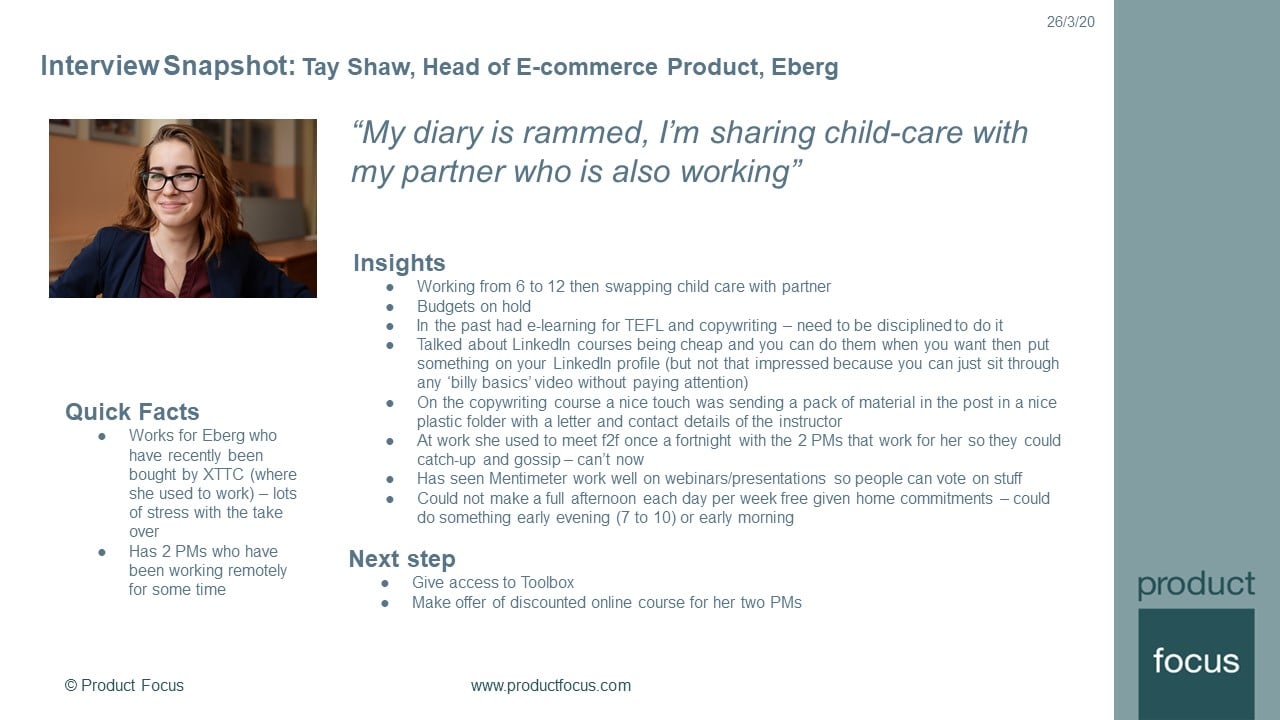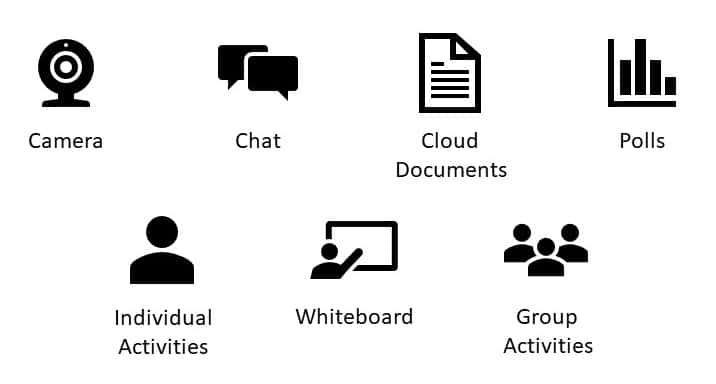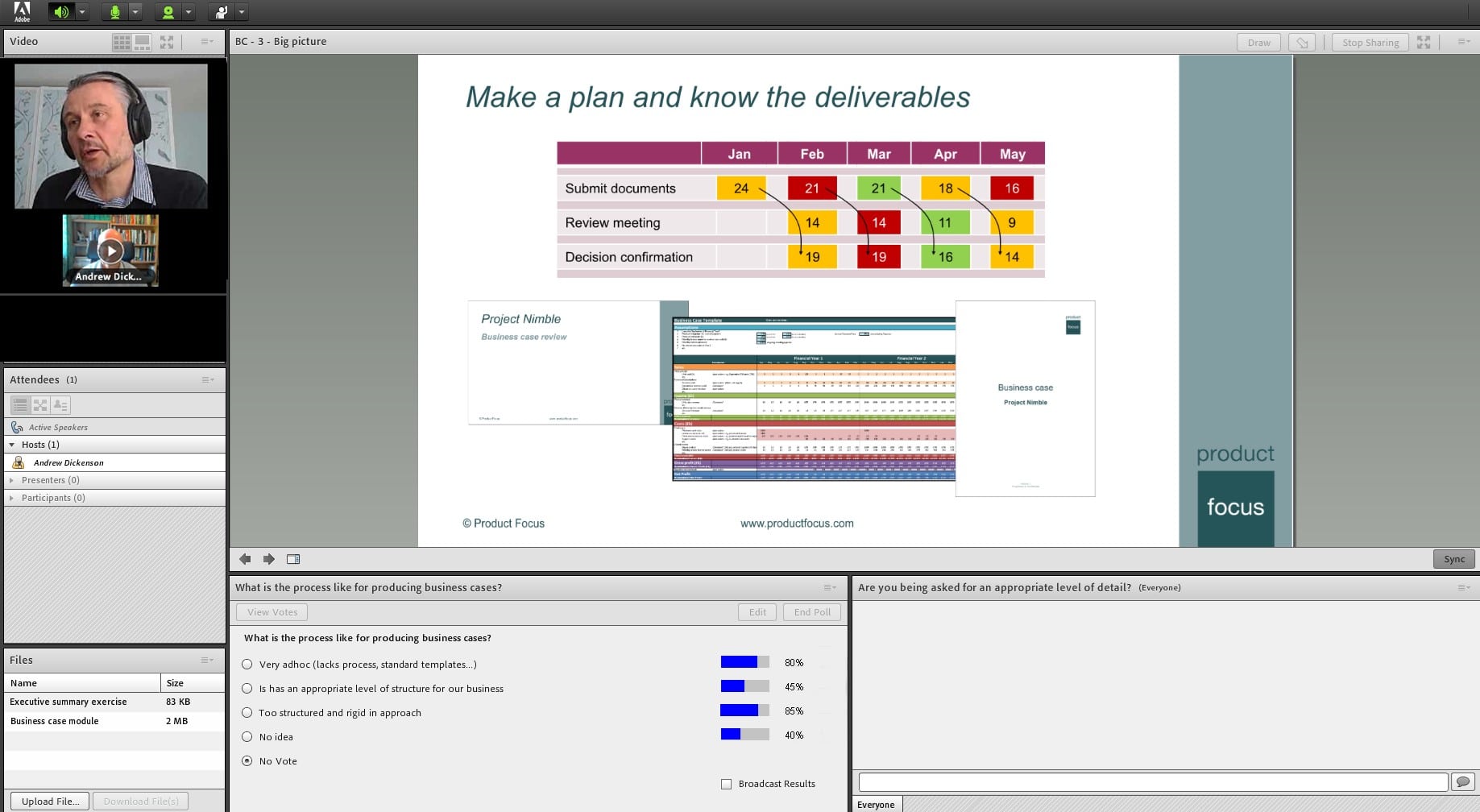
What we discovered about running online training
A few months ago, when Coronavirus hit, all our face-to-face product management training stopped! The phrase we use in the UK is ‘it dropped off a cliff.’
As this is a core part of what we do at Product Focus, we faced a crucial question. “If we can’t do face-to-face training, can we sell and deliver online training?”
But, a couple of other important questions came with it. “What does great online training look like? And can it be as good as face-to-face training?”
Not knowing the answers, we set out to do some discovery.
We didn’t want to be “just another training business that jumped online.” We wanted to ensure that customers got the same world class experience they receive in our face-to-face training. However, we recognized that many of the techniques we use in a room to drive a great experience simply wouldn’t work online.
Our first instinct was to create a batch of “pre-canned” videos that people could watch in their own time. But we soon realized this wouldn’t give an engaging learning experience that would keep delegates focused and energized.
We didn’t think that opening Zoom or any other platform and merely presenting the slides that are part of our course would work either.
Inherently, we recognized that a large part of our training’s value comes from interacting with product management experts and sharing questions and anecdotes with other delegates.
Multiple tracks of work
We made a plan that divided the work into several tracks, with different people taking the lead in different areas.

Planning and discovery
One of our team did a technical evaluation of the two tools that seemed to offer the most promise – Zoom and Adobe Connect. We opted for Adobe Connect as it was the market leader for online training with roughly 50% market share. It also provided more options to add engaging and dynamic content and interactive elements.
Two of the team took on doing a quick adaptation of the course with our “best guess” of what would work as we had a client that had done the first day of a face-to-face course, and we needed to finish the delivery for them! This was our Minimum Viable Product (MVP).
Another pair kicked off a User Panel, asking if anyone in our community would like to join and provide their insights.
We all attended other online courses, listened to webinars, spoke to experts, and read lots of material on the internet.
Obviously, we couldn’t ignore marketing and messaging too. We set out to define and refine the proposition. We asked everyone we spoke to about their thoughts. We took insights from all sources and emphasized on the message and supporting materials.
How did the User Panel work online?
When we initially envisaged the User Panel, it was a small group of 15 people that we would talk to as a group. But the reality is we were overwhelmed by the support and interest from worldwide.

User group
Because everyone was working from home and facing similar issues, there was a lot of goodwill and interest shown by our customers and prospects. Plus, we had a lot to learn – so we decided to talk to as many people as quickly as possible.
We started by asking everyone to complete a survey to help us target the right people for the proper discussions. We wanted to ensure that the questions we would ask them were answerable from their experience, not just their guesses – thereby avoiding less reliable answers and wasting peoples’ time.
We then engaged in one-to-one video chats. Often recording them and always noting the facts, key insights, and opportunities for each session. We would pull out a single quote to capture the key insight from the discussion. All of this was recorded on a single page with a picture of the interviewee. It was a great and simple way of documenting our interview findings.

Original Template Source: Teresa Torres
One group contained senior people or potential business opportunities, people who could help us understand how a compelling proposition for online training looked.
Another set of people who had online training experience became our expert group. With a further group, we explored their experience of justifying training in the current context.
We effectively went from a User Panel to a pool of people who allowed us to conduct some excellent product discovery. We were practicing what we preach – getting out there (metaphorically) and talking to customers to understand their needs. It was fun, as well as enlightening – getting back to basics.
Evolving approach
As we began to deliver the course, we found things we would do differently daily.

Online interactions
We tried different ways of doing exercises within the same course.
Sometimes we used group breakouts; other times, individual activities; sometimes, we used shared cloud documents; other times, we used the whiteboard function built into the platform. Sometimes we used chats, other times polls. Like all good product managers, we were running experiments!
After each course, we captured the learning and fed it back to the rest of the group. That allowed us to refine the course for the next delivery.
We have delivered the course lots and lots of times now, so the core has become stable, but there are still incremental improvements we continue to make. Instead of what was sometimes daily changes, we have slowed the pace to monthly increments.
What did we learn? – it’s about interaction!
We learned that interaction is critical. That can’t be overemphasized. But it takes a lot of effort to do online!
Interaction online isn’t the same as face-to-face. We learned that most people don’t want their cameras on for the full session. They don’t want to be scrutinized by other people all the time. For others, their home broadband speed meant that video just didn’t work, and some even had their camera disabled by their company’s IT department!
Not having video reduces the ability to interact quickly and build rapport.

Our delivery set-up
We are all used to reading body language face-to-face, but this isn’t as easy online. You have to develop a new skill of reading “digital body language.” This takes on board several different factors. Noting how quickly or often people respond to questions, looking at the “inactivity monitor” built into the platforms, and many other aspects. It’s not the same, but you can start to get a feel for what the people in the session think as things go along.
There is another reason that it’s hard for the instructor. In a room, there is a natural reflection of energy from the people that are there. As with a stand-up comedian, the audience interacts and responds. You can see them and gauge how things are going – to steer and adapt your delivery. At Product Focus, we all have skills at this after years of interacting face-to-face. But this isn’t there online, so it is very draining. It can feel like you are delivering into a void at times.
But every group is different, so it’s even more important to adapt the delivery style for the online experience. We regularly call delegates by their names and ask them for their experiences with a specific issue. Our delegates love learning from the experiences of their peers, and it keeps everyone on their feet to be ready to share their thoughts, and it makes for a more engaging experience.
Is online training as good as face-to-face training?
It’s a good question.
Most people are biased toward face-to-face because they usually have 15-20 years of experience. This has been their primary learning method through their school and university (or college). It is familiar, and they know it works.
Our view is that one is not better or worse. Is a home-cooked meal better than a meal in a fancy restaurant? It depends on what you want at the time, what’s most convenient, and what’s available.

Online training interface
Face-to-face training allows you to meet other delegates and the instructor in person. With online training, you interact with everyone via your screen, but you don’t have the travel costs, and you can get people from all over the world together much more easily.
And there are different types of online training …
You might have experienced self-paced e-learning where you read some documents, watch a set of online videos, and do some tests. It’s easy to switch off. It’s easy to get distracted.
Another version of online training is a live interactive event where you attend and work with a small number of other delegates supported by instructors. It’s much more immersive and engaging.
To counter people’s bias toward face-to-face training, we have been offering free online taster sessions to prospective delegates to experience what it’s like.
What does great look like?
Through this process, our key findings of what makes great online training are:
- Lots of opportunities for different types of interaction – regular interaction every few minutes using a range of methods is key to keeping people engaged and not drifting off into other work like checking their e-mail.
- Good content is delivered in an engaging way – video calls have a tendency to flatten your voice, so you need to put more effort into the vocal performance. Storytelling throughout is also important to help bring the theory to life, supported by visuals that keep the screen moving.
- Well-structured with good time management and lots of breaks – there needs to be clarity on how the material is organized and then broken up so that people aren’t stuck at their screens for long durations. A good target we found is 45 mins delivery, including activities, followed by 10 mins break. If you run much longer, people struggle to stay focused.
- Small groups – to keep the interaction high and be able to engage with individuals, the groups need to remain small. When going online, there is a temptation to have many more people in a session because the physical constraints aren’t the same. Resist the urge so you can engage with people.
- Two instructors with one acting as a facilitator – having someone running the technology and dealing with any issues is beneficial for the instructor as they can focus purely on delivery and interaction. The facilitator can also provide insights and one-to-one interactions with delegates using chat windows. Alternating who delivers each module gives the audience a change of voice and the instructors a bit of a break. Finally, if one of the instructor’s broadband goes down, the other can pick up the delivery.
- Stable and high-quality technical setup – there are many tools out there. They are not all created equal. We opted to use Adobe Connect to provide the best control for us and the richest experience for the learners. It’s not without its compromises, though, as it is a higher effort to maintain and change the course, but with the effort comes a better outcome for the learners.
- Pre-course ‘tech check’ – we always try to do a quick pre-course ‘tech check’ with each delegate to let them get used to the tool, make sure their tech set-up works and reduce the risk of delays at the beginning of the training.
- Blended learning for deepening and more effective application – online is one thing, but there is only so much you can do in the time you have online, so providing material to look at before and after allows learners to go deeper.
Combining all of these in a balanced and effective way is not easy, but if you want to deliver great online training … they all matter!
Success?
We think that our approach has meant that the course we are now delivering is hitting the same world class levels as our face-to-face version.
We approached developing it the same way we teach product managers – doing our research, setting up a user panel, developing an MVP, and iterating the solution. And the solution we came to has proven to be very successful. We have run the course many times and are getting great feedback, including 5-star Trustpilot ratings and video testimonials. And, we’ve had delegates from across the world – from New Zealand to California.
Phil Hornby
Independent Consultant
Jan Harste
Product Focus Senior Consultant and Independent Consultant
Ian Lunn
Product Focus Founding Director


Leave a comment